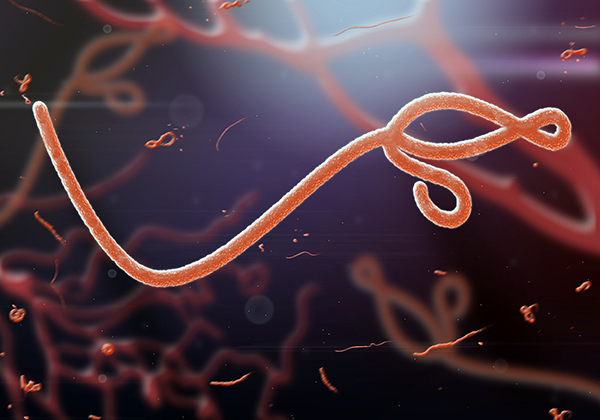By Sarah Glass

Many people associate Ebola with the previous viral epidemic of the last decade, but, especially in light of the current global SARS-CoV-2 pandemic, few are aware that there is currently an active outbreak occurring in the Democratic Republic of the Congo. This deadly virus continues to wreak havoc in Africa, where containment of the virus fluctuates as new cases are reported. Researchers from the lab of James Crowe (Pediatrics) are hoping to change the narrative, reporting in Immunity that they have developed a new therapeutic cocktail against multiple strains of the Ebola virus that not only protects but also limits virus mutation so that it cannot spread to others.
By using a panel of antibodies from Ebola survivors, first author Pavlo Gilchuk and colleagues identified two antibodies that bind to different portions of the virus, allowing for a high rate of recognition and neutralization of the virus within an infected individual. The team discovered that one antibody enhanced the binding of the other, creating cooperativity within the cocktail, and demonstrated that the combination could recognize all three of the Ebola virus strains that have resulted in outbreaks.
These antibodies are effective because they attach at residues that are conserved among the viruses and mimic the protein structure of the virus to enhance binding. The effect of the two antibodies together improved virus neutralization over use of either one alone.
Moving forward, it is imperative to develop therapeutics that can find and neutralize Ebola virus not just before it leads to patient deaths, but before the virus itself mutates and spreads in new forms that might not be as treatable. For this reason, the researchers looked at whether or not the antibody cocktail could effectively eliminate the virus without giving rise to mutants.
They used a unique assay that assesses virus invasion in real time and found that mutants propagated when cells were treated with either one of the antibodies alone, but not when they were used as a cocktail. Reducing the emergence of resistant strains with the cocktail is a major accomplishment over the therapy options currently available, which mostly rely on single antibodies.
Perhaps most importantly, when the cocktail was tested in rhesus macaques that were challenged with the Ebola virus, only two cocktail doses spaced three days apart were necessary for full protection from mortality and even typical symptoms. An Ebola therapy that cures in only two doses within a week’s time could tremendously impact outbreak management by fostering the quick dissemination of and patient adherence to treatment.
This work identifies a new therapy against the Ebola virus that could turn the tide of the current outbreak in the Congo and help prevent future outbreaks. It also details a translatable strategy to develop antibody cocktails against a variety of other viruses that threaten human health, including COVID-19.